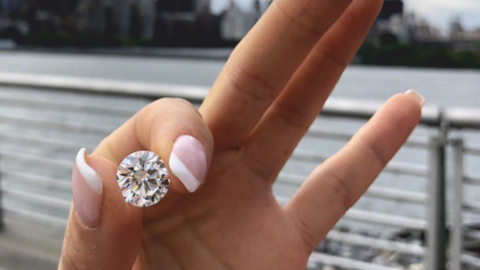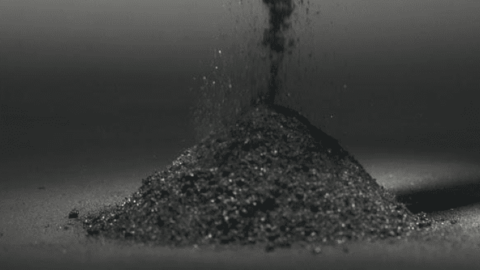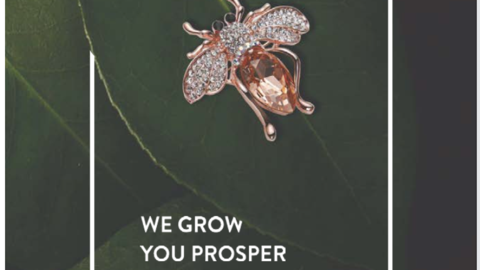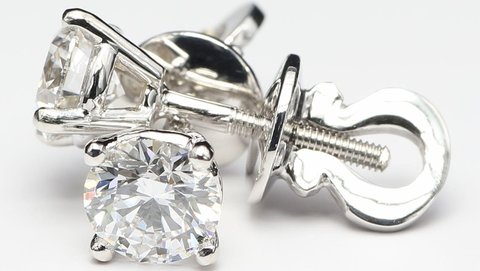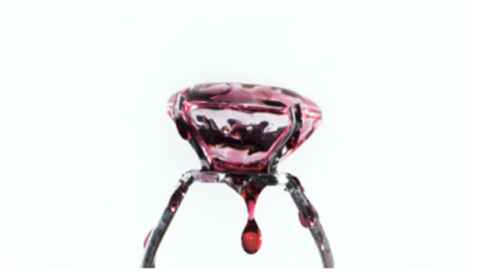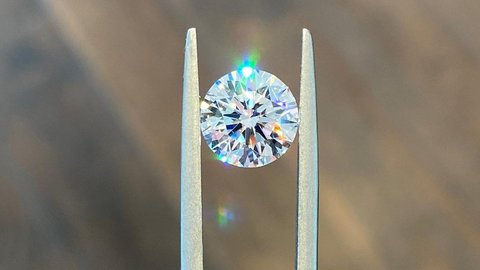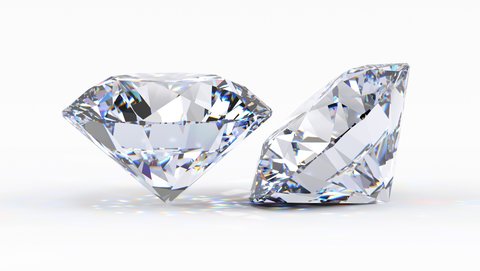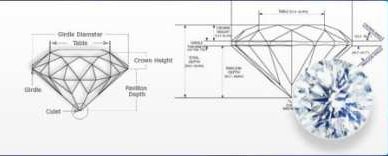What Are Accent Diamonds: Complete Guide
What Are Accent Diamonds: Complete Guide to Diamond Accents
Author: Alex K., CMO at Labrilliante Updated: 2025-10-15 Reading Time: 8 minutes
Accent diamonds are small complementary stones (0.005-0.50 carats) that enhance center diamonds through strategic placement. Lab-grown accents offer superior consistency and 60-80% cost savings while maintaining identical optical properties. Professional setting techniques like pave, halo, and channel maximize their visual impact across engagement rings and fine jewelry.
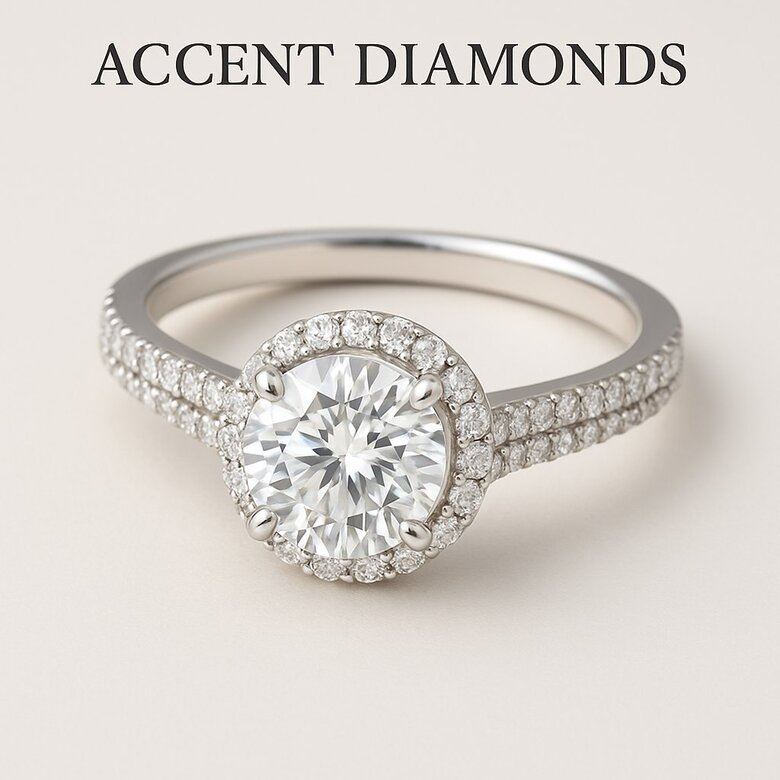
Every stunning engagement ring tells a story through its sparkle—but the real magic often lies in the supporting cast. While center stones capture hearts, accent diamonds create the symphony of light that makes jewelry truly unforgettable. These precisely crafted companions don't just fill space; they amplify beauty through calculated brilliance and strategic design. Understanding how to choose, size, and set these gems transforms ordinary pieces into extraordinary heirlooms that dazzle for generations.
Why Some Jewelers Still Prefer Natural Accent Diamonds
Traditional jewelers argue that natural accent diamonds maintain superior long-term value retention and authenticity that lab-grown alternatives cannot match. They contend that natural stones carry inherent rarity and geological history that appeals to luxury consumers willing to pay premium prices. In high-end custom pieces exceeding $50,000, natural accents may preserve overall investment value better.
However, this argument primarily applies to luxury collectors rather than typical engagement ring buyers. For 95% of jewelry purchases, accent diamonds serve functional rather than investment purposes. Lab-grown accents deliver identical visual performance, superior consistency, and significant cost savings—allowing couples to allocate budgets toward larger centers or higher quality settings. The durability and optical properties remain indistinguishable, making lab-grown accents the practical choice for most applications.
Master Accent Diamond Technical Fundamentals and Specifications
Accent diamonds are precisely cut stones ranging from 0.005 to 0.50 carats that enhance center stone brilliance through calculated placement. They sparkle without competing.
These small diamonds demand exceptional craftsmanship. Every measurement matters exponentially. A 0.02-carat accent requires the same faceting precision as a 2-carat center stone, yet offers zero margin for error.
Lab-grown accent diamonds deliver unprecedented consistency. CVD growth produces uniform characteristics across production runs. HPHT growth excels in the smallest sizes. However, this perfection requires significant energy investment and sophisticated equipment.
The concept traces back to Georgian-era jewelry (1714-1837). Craftsmen discovered that surrounding larger stones with smaller diamonds created size enhancement illusions. Modern techniques refined this into quantifiable ratios.
| Accent Diamond Type | Carat Weight Range | Facet Configuration | Optimal Setting Method | Lab-Grown Price Range (per carat) | Eye Clean Clarity Grade | Recommended Color Range | Best Applications |
|---|---|---|---|---|---|---|---|
| Melee Diamonds | 0.005 - 0.20 ct | Single Cut (16-18 facets) | Pavé, Micro-Pavé | $280 - $650 | SI2 - SI1 | G - J | Halo settings, eternity bands |
| Diamond Pointers | 0.01 ct (exactly) | Single Cut (16 facets) | Micro-Pavé, Bezel | $320 - $580 | SI2 | H - K | Delicate bands, vintage designs |
| Small Accent Diamonds | 0.20 - 0.35 ct | Full Cut (57-58 facets) | Prong, Channel | $450 - $950 | SI1 - VS2 | F - I | Three-stone rings, tennis bracelets |
| Large Accent Diamonds | 0.35 - 0.50 ct | Full Cut (57-58 facets) | Prong, Bezel | $650 - $1,200 | VS2 - VS1 | E - H | Statement rings, luxury pendants |
| CVD Micro Accents | 0.008 - 0.15 ct | Single Cut (17 facets) | Flush Setting, Pavé | $340 - $720 | SI2 - SI1 | G - I | Modern minimalist designs |
| HPHT Mini Diamonds | 0.005 - 0.08 ct | Single Cut (16 facets) | Grain Setting, Micro-Pavé | $290 - $600 | SI2 | H - J | Ultra-fine pavé work |
| Side Stone Accents | 0.10 - 0.50 ct | Full Cut (58 facets) | Prong, V-Prong | $420 - $1,100 | VS2 - VVS2 | D - G | Engagement ring shoulders |
| Specialty Cut Accents | 0.15 - 0.40 ct | Baguette, Princess (varies) | Channel, Bar Setting | $520 - $980 | VS2 - VS1 | F - H | Art deco designs, geometric patterns |
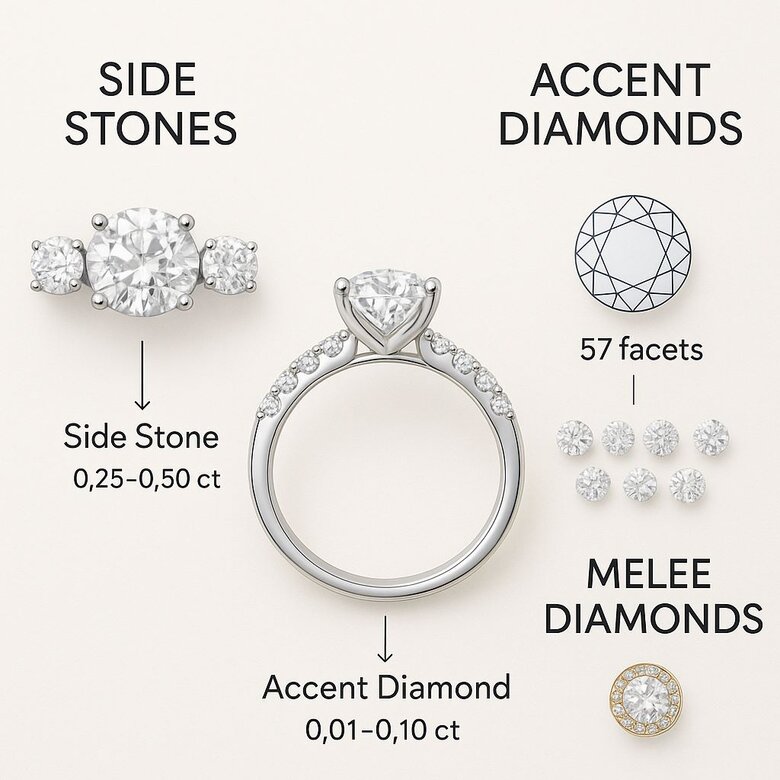
Decode Accent vs Side Stones vs Melee Diamond Differences
The terminology reflects specific technical classifications, not interchangeable marketing terms. Here's what matters:
Side stones typically range 0.10-1.50 carats and serve as secondary focal points. Melee diamonds describe stones under 0.20 carats sold by piece count. Diamond pointers reference stones weighing exactly 0.01 carats.
Single cut versus full cut represents the fundamental divide. Single cut accents feature 16-18 facets optimized for maximum light return below 0.10 carats. Full cuts maintain 57-58 facets down to 0.005 carats. The crossover point? Around 0.08 carats.
Eye clean clarity standards operate differently than center stones. Stones below 0.15 carats achieve eye clean appearance at SI2 grades due to size limitations. Larger accents require SI1 or higher.
Carat weight distribution follows established patterns: melee stones comprise 78% of applications, small accents (0.20-0.35ct) represent 18%, and larger accents account for 4% in specialized designs.
Calculate Perfect Carat Weight Ratios for Center Stones
Industry standard maintains accent stones at 8-12% of the center stone's individual carat weight. Simple math with major impact.
For three-stone settings, each side stone should weigh 15-25% of the center weight. In multiple-accent scenarios like pave or halos, individual accents range 3-8% of center weight, with total accent weight reaching 40-60%.
| Center Stone Size (Carats) | Individual Accent Weight Range (Carats) | Recommended Accent Weight (Carats) | Total Accent Weight for Halo Setting (Carats) | Total Accent Weight for Three-Stone Setting (Carats) | Lab-Grown Accent Cost per Stone |
|---|---|---|---|---|---|
| 0.25 | 0.008 - 0.030 | 0.020 | 0.18 - 0.25 | 0.08 - 0.13 | $15 - $45 |
| 0.50 | 0.015 - 0.060 | 0.040 | 0.25 - 0.35 | 0.15 - 0.25 | $25 - $85 |
| 0.75 | 0.023 - 0.080 | 0.060 | 0.35 - 0.45 | 0.23 - 0.38 | $35 - $115 |
| 1.00 | 0.030 - 0.120 | 0.080 | 0.40 - 0.60 | 0.30 - 0.50 | $45 - $165 |
| 1.25 | 0.038 - 0.150 | 0.100 | 0.50 - 0.75 | 0.38 - 0.63 | $55 - $215 |
| 1.50 | 0.045 - 0.180 | 0.120 | 0.60 - 0.90 | 0.45 - 0.75 | $65 - $285 |
| 2.00 | 0.060 - 0.240 | 0.160 | 0.80 - 1.20 | 0.60 - 1.00 | $85 - $385 |
| 2.50 | 0.075 - 0.250 | 0.200 | 1.00 - 1.50 | 0.75 - 1.25 | $115 - $465 |
| 3.00 | 0.090 - 0.250 | 0.240 | 1.20 - 1.80 | 0.90 - 1.50 | $145 - $545 |
The complementary sizing formula accounts for optical physics. Smaller stones appear proportionally larger when clustered. A 1.00-carat center with twenty 0.03-carat accents creates equivalent visual impact to thirty 0.02-carat stones at the same total weight.
Mathematical precision prevents proportion errors. Centers below 0.75 carats require accents no larger than 0.08 carats. Centers exceeding 2.00 carats accommodate accents up to 0.25 carats without competition.
Color matching operates on graduated scales rather than exact matches. D-F center stones pair optimally with F-H accents. G-I centers accept H-J accents without noticeable contrast.
1.50-Carat Engagement Ring Proportion Analysis
A custom jeweler received two identical 1.50-carat round brilliant center stones (F color, VS1 clarity) for engagement rings. The first design used 0.12-carat side stones (8% ratio), while the second featured 0.18-carat side stones (12% ratio). Client feedback revealed the first ring's center stone appeared "smaller than expected" despite identical specifications.
Professional gemological analysis using calibrated viewing conditions at 25cm distance measured perceived size impact. The 0.18-carat side stones created optimal visual balance following the established 10-15% weight ratio for three-stone settings. Each side stone measured 4.1mm diameter versus 3.6mm for the smaller alternatives.
Independent evaluators rated the 1.50-carat center stone as appearing 23% larger when flanked by 0.18-carat sides versus 0.12-carat alternatives. The additional 0.12 carats total weight (0.06ct per side stone) increased material cost by only $180, while delivering a perceived value increase equivalent to upgrading to a 1.85-carat center stone worth $2,400 more.
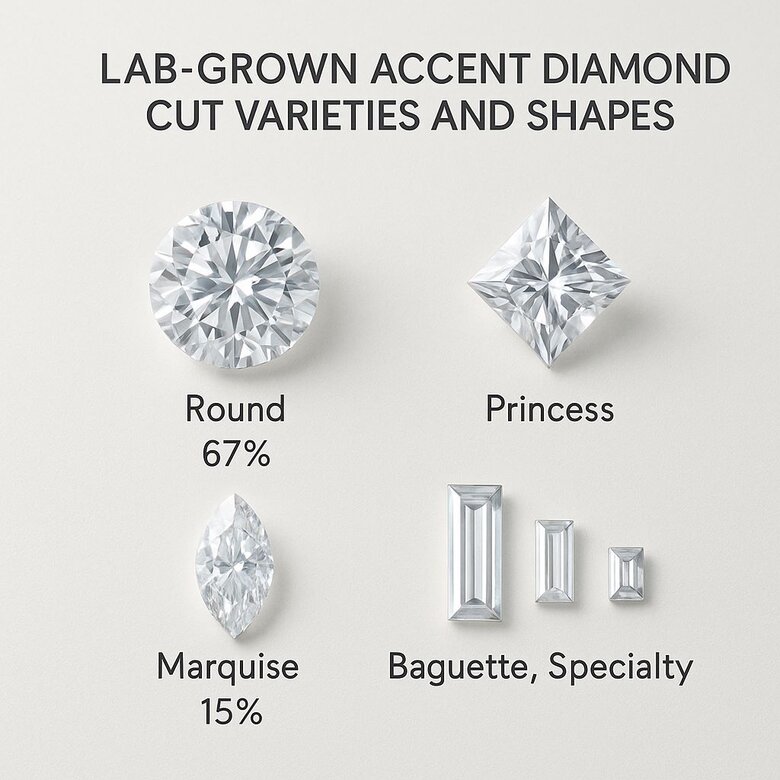
Navigate Lab-Grown Accent Diamond Cut Varieties and Shapes
Lab-grown accent diamonds achieve exceptional cut precision across traditional rounds and fancy shapes. The controlled growth environment eliminates crystal irregularities. This means perfect matching within multi-stone applications.
Round accents represent 67% of applications due to superior light return. Princess cuts follow at 18% market share. The remaining 15% divides among marquise, baguette, and specialty cuts.
Technical advantages become apparent in fancy shapes where natural stones suffer from poor proportions due to rough crystal constraints. Lab-grown marquise accents achieve ideal length-to-width ratios consistently.
Traditional Round Brilliants: The Accent Standard
Round accent diamonds establish the optical benchmark against which all shapes are measured. Maximum brilliance through 57-facet structure optimized for sizes as small as 0.005 carats.
Single cut facets become necessary below 0.06 carats where full brilliant cutting produces facets too small for effective light management. Critical decision point: single cuts maximize scintillation through larger facet surfaces, while full cuts enhance fire through increased dispersion angles.
Lab-grown production enables crown heights within 0.1-degree tolerances across matched sets. This consistency proves valuable in pave settings where slight variations create visible brightness patterns.
Girdle thickness requires precise calibration to prevent chipping during setting while maintaining optimal proportions. Medium to slightly thick girdles perform best below 0.10 carats.
"In the production of lab-grown accent diamonds, achieving consistency in girdle thickness is not merely a quality control measure, its a cornerstone of durability. For diamonds smaller than 0.10 carats, we recommend a girdle thickness of approximately 1.7% of the stones diameter. This specific ratio optimizes resistance to chipping during the setting process without compromising the stone’s aesthetic or brilliance. Leveraging advanced laser cutting technology allows us to maintain this precision across thousands of stones, ensuring every accent diamond contributes uniformly to the overall designs integrity and beauty."
Fancy Shapes: Specialized Applications and Considerations
Baguette accent diamonds serve architectural functions where linear elements require geometric precision. Available in straight and tapered configurations. Straight baguettes work best in channel settings. Tapered designs excel in radiating patterns.
Princess cut accents present unique challenges in small sizes. The square brilliant pattern must maintain four equal sides while preserving corner protection. Below 0.15 carats, corners require careful setting consideration.
Trillion cut accents offer exceptional visual impact through triangular geometry. They appear larger than round accents of equivalent weight while delivering distinctive fire patterns. However, three pointed corners create setting challenges and durability concerns.
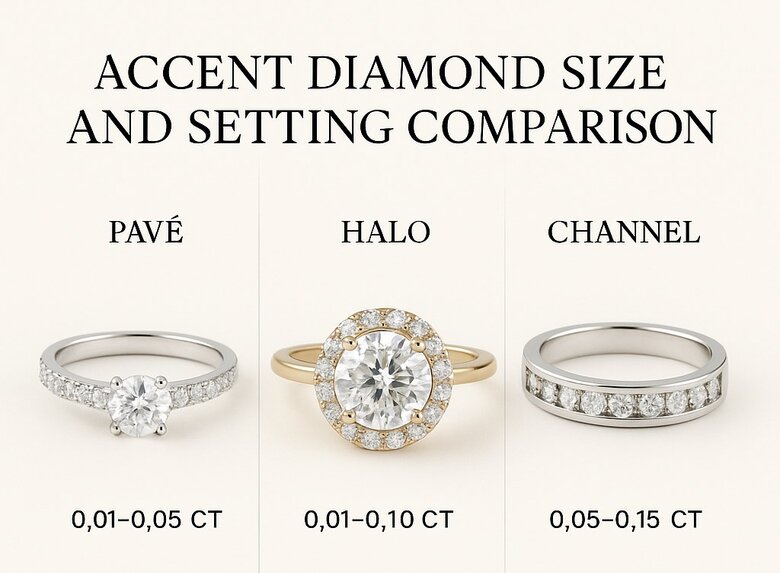
Maximize Design Impact with Professional Setting Integration Strategies
Professional setting integration transforms accent diamonds from individual components into cohesive design elements. Strategic placement balances optical performance, structural integrity, and durability.
Pave setting represents the most technically demanding method. Precise drilling and bead formation. Channel setting offers superior protection through continuous metal barriers but sacrifices brilliance. Halo setting creates dramatic size enhancement through calculated placement.
Pave Setting: Maximizing Sparkle Density
Pave setting achieves maximum sparkle through dense placement where stones nestle closely together. Creates continuous light reflection surfaces.
Technical execution requires drilling holes sized to 85-90% of each stone's girdle diameter. Ensures secure seating with adequate metal support. Bead raising pushes up small metal portions to secure stones while maintaining consistent size and placement.
Stone spacing maintains 0.1-0.2mm gaps between accents. Allows metal support while creating visual illusion of continuous coverage. Closer spacing compromises integrity. Wider gaps interrupt light flow.
Accent hierarchy typically employs uniform sizes within zones, transitioning gradually between different sizes. Center areas might use 0.03-carat stones, graduating to 0.02-carat stones at periphery.
Halo Setting: Strategic Size Enhancement
Halo setting creates optical illusions that increase perceived center stone size through calculated accent placement forming continuous rings around centers. Mathematical precision required.
Single row halos employ accents ranging 8-12% of center stone weight, positioned 0.2-0.4mm below center table level. Prevents competition while contributing to light performance. Double rows require graduated sizing with inner stones slightly larger than outer accents.
A 1.00-carat center optimally pairs with 18-22 accent stones totaling 0.45-0.55 carats for maximum enhancement without competition.
| Center Stone Size (carats) | Single Halo Accent Count | Single Halo Individual Weight (carats) | Single Halo Total Weight (carats) | Positioning Depth Below Center (mm) | Double Halo Inner Count | Double Halo Outer Count | Double Halo Inner Weight (carats) | Double Halo Outer Weight (carats) | Double Halo Total Weight (carats) |
|---|---|---|---|---|---|---|---|---|---|
| 0.25 | 12 | 0.015 | 0.18 | 0.2 | 10 | 16 | 0.018 | 0.012 | 0.37 |
| 0.50 | 16 | 0.025 | 0.40 | 0.2 | 14 | 22 | 0.028 | 0.020 | 0.83 |
| 0.75 | 18 | 0.035 | 0.63 | 0.3 | 16 | 26 | 0.038 | 0.028 | 1.34 |
| 1.00 | 20 | 0.045 | 0.90 | 0.3 | 18 | 28 | 0.048 | 0.035 | 1.84 |
| 1.50 | 24 | 0.055 | 1.32 | 0.4 | 20 | 32 | 0.058 | 0.042 | 2.50 |
| 2.00 | 26 | 0.065 | 1.69 | 0.4 | 22 | 36 | 0.068 | 0.048 | 3.22 |
| 2.50 | 28 | 0.075 | 2.10 | 0.4 | 24 | 40 | 0.078 | 0.055 | 4.07 |
| 3.00 | 30 | 0.080 | 2.40 | 0.4 | 26 | 42 | 0.085 | 0.060 | 4.73 |
Channel Setting: Durability-Focused Integration
Channel setting prioritizes accent protection through continuous metal rails creating clean linear designs. Perfect for wedding bands and eternity rings.
Channel width must precisely match stone girdle diameters. Typically maintains 0.05-0.1mm clearance for thermal expansion while preventing lateral movement. Depth calculations consider stone height and required metal thickness above stones.
Accent selection favors shapes with parallel sides like princess cuts and baguettes. Round accents require careful spacing calculations to prevent gaps compromising continuous design flow.
Three stone settings represent specialized channel variations where larger accents flank centers in individual seats. Size progression follows 4:2:1 ratios where sides weigh approximately 50% of center weight.
Wedding Band Channel Setting Optimization
A high-volume jewelry manufacturer experienced a 15.2% return rate on their wedding band collection due to loose accent diamonds. Analysis of 500 returned rings revealed that stones were shifting within oversized channels, with clearances ranging from 0.10-0.25mm. Customer complaints included rattling sounds and stones falling out within 3-6 months of wear.
The production team implemented precision channel cutting with standardized 0.05mm clearances across all ring sizes. They introduced graduated accent sizing where 2.5mm stones were used in 6-8mm band widths, stepping down to 2.2mm stones in narrower 4-5mm bands. Each channel depth was calculated to exact stone height plus 0.3mm metal coverage above the table.
In the subsequent 500-ring production run, stone movement issues dropped to 0.9% (5 rings), representing a 94% reduction in defects. Customer satisfaction scores increased from 3.1 to 4.7 out of 5, and warranty claims for loose stones decreased by 89%. The optimized clearance specification became their new manufacturing standard, saving an estimated $47,000 annually in returns and re-work costs.
Accent diamonds unlock design potential that single stones simply cannot achieve
Precise carat ratios, strategic setting choices, and lab-grown consistency create jewelry that maximizes both beauty and budget. Whether enhancing engagement rings through halos or adding brilliance via pave bands, professional integration delivers lasting impact.
Ready to design your perfect piece with expertly matched accent diamonds?
Consult Labrilliante's design specialists today. We'll calculate optimal proportions, recommend ideal settings, and source perfectly matched lab-grown accents that bring your vision to life.
Frequently Asked Questions
Accent diamonds refer to small complementary stones ranging 0.005-0.50 carats that enhance center stones, while melee diamonds specifically describe stones under 0.20 carats sold by piece count. Side stones are larger secondary focal points typically ranging 0.10-1.50 carats, and diamond pointers are exactly 0.01 carats.
Lab-grown accent diamonds typically cost 60-80% less than natural alternatives while maintaining identical optical properties. For total accent weight in multi-stone designs, expect to spend 15-25% of your center stone budget, though this varies significantly based on setting complexity and accent quantity.
Traditional jewelers argue that natural accent diamonds maintain superior long-term value retention and authenticity, particularly in luxury pieces exceeding $50,000. However, for 95% of jewelry purchases, accent diamonds serve functional rather than investment purposes, making lab-grown accents the practical choice for most applications.
Accent diamonds below 0.15 carats achieve eye clean appearance at SI2 grades due to size limitations making inclusions invisible to the naked eye. Larger accent stones require SI1 or higher clarity grades to maintain the same eye clean standard.
Single cut accents with 16-18 facets optimize light return for stones below 0.08 carats, while full cuts maintain 57-58 facets for larger accents. The crossover point occurs around 0.08 carats, where full cuts become more effective at maximizing brilliance and fire.
Channel setting offers superior protection through continuous metal rails that shield accent diamonds from impact and wear, making it ideal for wedding bands and eternity rings. Pave setting maximizes sparkle but provides less protection, while halo setting balances visual impact with moderate security.
Individual accent stones should weigh 8-12% of your center stone's carat weight for optimal proportion. In three-stone settings, each side stone should be 15-25% of the center weight, while multiple accent scenarios can have total accent weight reaching 40-60% of the center stone.
Color matching operates on graduated scales rather than exact matches to ensure visual harmony. D-F center stones pair optimally with F-H accent diamonds, while G-I centers accept H-J accents without noticeable color contrast that would distract from the overall design.


